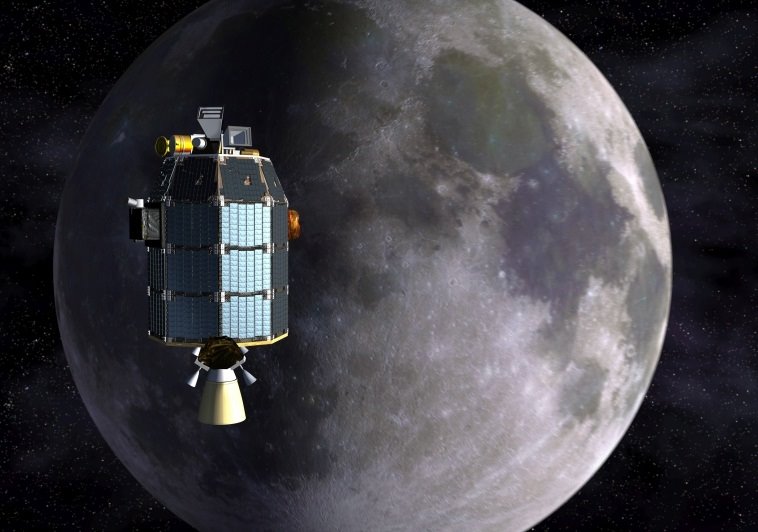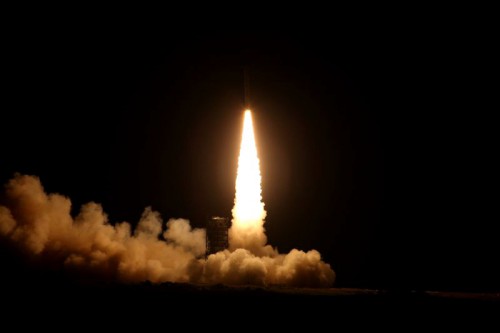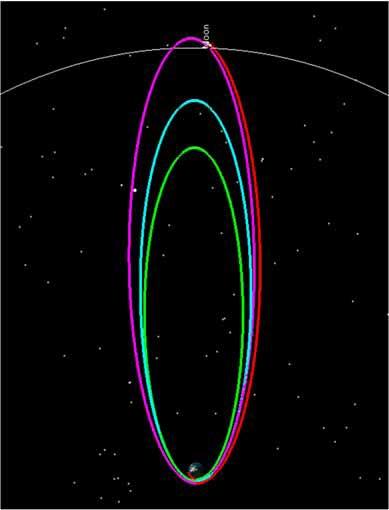
One month since its launch atop the first Minotaur V rocket from Wallops Island, Va., NASA’s Lunar Atmosphere and Dust Environment Explorer (LADEE) has completed the first of its critical Lunar Orbit Insertion (LOI) maneuvers to inject itself into orbit around the Moon. The $280 million spacecraft successfully began its four-minute-long LOI-1 burn at 6:57 a.m. EDT Sunday, which served to establish it in a 24-hour orbit with a “periselene” (or closest point) of about 590 km above the surface of our nearest celestial neighbor. Over the next few days, LADEE will execute two additional LOI burns to fine-tune this orbit into a circular path at an altitude of about 250 km, after which it will begin a 40-day “Commissioning Phase,” ahead of several months of full scientific operations.
Although NASA’s websites remain out of service, due to the ongoing U.S. Government shutdown, details about the progress of the LADEE mission have trickled out through a number of outlets. According to The Planetary Society, the spacecraft will remain in this initial lunar orbit for three revolutions. “After three revolutions in this orbit,” noted the society’s Emily Lakdawalla, “third-body Earth gravitational perturbations will have lowered periselene to an altitude of 250 km (by design). At this point, LOI-2 will be performed on 9 October 2013 … to place LADEE into a four-hour orbit, also with a 250 km periselene altitude. LADEE will spend three days in this orbit, until LOI-3 (12 October 2013), which circularizes the orbit at 250 km.”

LADEE was blasted into space by Orbital Sciences Corp. on 6 September, atop the first Minotaur V rocket, from Pad 0B at the Mid-Atlantic Regional Spaceport (MARS) on Wallops Island, Va. Although this five-stage vehicle—which represents a marriage of the lower three stages of the Peacekeeper missile, topped by the Star-48V motor of the fourth stage and a spin-stabilized Star-37FM of the fifth—produced insufficient impulse to deliver LADEE directly to the Moon, it was powerful enough to insert the spacecraft into a highly elliptical Earth orbit and onto the first of three so-called “phasing loops.” These loops served to gradually expand the apogee of its Earth orbit to gradually reach the Moon and be successfully captured by lunar gravity.
Hearts leapt into mouths shortly after the spacecraft separated from the Minotaur’s final stage, when LADEE experienced a temporary power surge and began tumbling. The immediate effect of the surge was that its stabilization and control reaction wheels were shut down as a precautionary measure to prevent them from over-revving. Engineers quickly disabled the spacecraft’s fail-safe system to regain control of LADEE, and the problem was satisfactorily resolved a few hours into the mission.
By this stage, the spacecraft was in a highly elliptical Earth orbit, with an apogee of about 50 Earth-radii, and late on 11 September the first Apogee Maneuver (AM-1) was performed, serving as “an engineering test of the main Orbital Control System (OCS) thruster,” which would be critical for the LOI-1 burn. Next day, LADEE performed the AM-1b burn and NASA’s status summary was encouraging: “Everything looks good. The post-burn engineering assessment is that the main engine performed very well, with no issues.”

At 12:36 p.m. EDT on 13 September, the first Perigee Maneuver (PM-1) was completed, increasing the altitude of LADEE’s elliptical orbit and establishing the spacecraft onto the “cruise” phase on its journey to the Moon. “We are currently in elliptic orbits around Earth, calling phasing loops,” NASA explained at the time, “and will continue with two more of these elliptical orbits until LADEE is captured around the Moon.” Over the next few days, the scientific instruments were brought on line—the Neutral Mass Spectrometer (NMS) and Lunar Dust Experiment (LDEX) underwent “aliveness” and performance tests, whilst the Ultraviolet-Visible Spectrometer (UVS) completed a dark calibration test—and all were verified to be healthy. On 21 September, the PM-2 burn established LADEE onto its third phasing loop, scheduled to last 10 days, and was described by NASA as “extremely accurate”—so accurate, in fact, that a planned PM-3 burn was unnecessary.
Last Tuesday (1 October), the spacecraft passed Earth for the final time and performed a Trajectory Correction Maneuver (TCM) to fine-tune its path to lunar orbit. On Saturday afternoon, it was reported that LADEE had successfully “entered the Moon’s Sphere, meaning that the Moon was the primary gravitational body acting on the vehicle, starting to pull the spacecraft in.” This led up to today’s big LOI-1 burn, which Spaceflight101 described as “one of the most critical events of the mission … without it, the spacecraft would have passed the Moon with no hope of returning.”
With the exception of the initial injection into the first phasing loop, which was achieved by the Minotaur V, and the actual capture of LADEE into lunar orbit, all of the spacecraft’s mission events were made with the on-board propulsion system. Late on Monday, 7 October, an optional trajectory maneuver may be completed to correct any errors, but the next major burn will be LOI-2 at 6:37 a.m. EDT Wednesday. This will steadily reduce LADEE’s orbit into a four-hour, almost-circular path, which it will occupy for three days. The LOI-3 burn is scheduled to occur at 6:37 a.m. EDT Saturday and will establish the spacecraft in a fully circular orbit at an altitude of about 250 km. This altitude has been selected due to its suitability for communications visibility to Earth and in order to minimize the need for further maneuvers during LADEE’s 40-day Commissioning Phase.
Checkouts of the spacecraft and its scientific instruments will occupy the first few days of the Commissioning Phase, followed by aliveness tests and finally the deployment of the LDEX, UVS, and NMS covers. For the remainder of the commissioning period, LADEE will perform high-altitude science checkouts and tests of its Lunar Laser Communications Demonstration (LLCD) instrument. The latter is an experimental laser communications (or “lasercomm”) terminal, which will transmit and receive data as pulses of light from three Earth-based ground stations. It successfully “phoned home” during a test en-route to the Moon on Sunday, 29 September.
In the final few days of the Commissioning Phase, LADEE will steadily lower its orbit, initially to about 75 km and eventually into the “Science Phase” orbit of between 50-150 km. “Due to the unevenness of the Moon’s gravitational field,” noted NASA’s LADEE press kit, “the orbit requires significant orbit maintenance activity with maneuvers taking place as often as every 3-5 days or as infrequently as once every two weeks. Orbit Maintenance Maneuvers will be used to keep LADEE’s lowest altitude above 50 km and highest altitude below 150 km to the extent possible.” During the 100-day Science Phase, the Moon will rotate more than three times under the spacecraft’s orbit.
The next several months will be spent investigating the density and composition of the Moon’s atmosphere, as well as helping to determine if observations by Apollo astronauts of diffuse, high-energy emissions were due to “sodium glow” or dust particles and documenting the dust-impactor environment to guide plans for future missions. “The Moon’s tenuous atmosphere may be more common in the Solar System than we thought,” said former astronaut John Grunsfeld, now NASA’s associate administrator for science in Washington, D.C. “Further understanding of the Moon’s atmosphere may also help us better understand our diverse Solar System and its evolution.”
Want to keep up-to-date with all things space? Be sure to “Like” AmericaSpace on Facebook and follow us on Twitter: @AmericaSpace
Missions » LADEE »



2 Comments
2 Pings & Trackbacks
Pingback:Ahoy From LOI: NASA’s LADEE Spacecraft Enters Lunar Orbit | Today in Space
Pingback:Allgemeines Live-Blog ab dem 4. Oktober 2013 | Skyweek Zwei Punkt Null